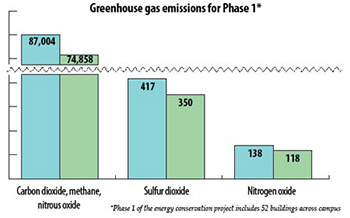KSU to save about $5 million from conservation efforts

Graphic by Kate Edwards
July 1, 2013
Kent State will save about $5 million in annual utility costs and reduce green house gasses equivalent to removing 3,500 cars thanks to increased energy conservation efforts across campus.
In 2007, Ohio enacted House Bill 251, which mandated higher education institutions to reduce 20 percent of energy use by 2014. Although Kent State has previously done energy conservation projects, this bill pushed them to look into more projects to meet that goal with the help of the Brewer-Garrett Company, according to Bob Misbrener, project II manager at the Office of the University Architect.
“Although there’s no penalty if you don’t meet the 20 percent, it’s a goal and we really wanted to hit that goal,” Misbrener said. “I think we’re going to be there.”
After the request of a $25 million phase one proposal, as part of the Foundations of Excellence – Building the Future initiative, and the Ohio Air Quality Development Authority’s (OAQDA) funding was approved, phase one began late October 2012. Of the 52 buildings planned for phase one, the most significant work being done is in the Michael Schwartz Center, the Ice Arena, M.A.C. Center, Bowman Hall and the University Library, according to Misbrener. William Switaj, Ice Arena manager, said the energy conservation additions were a nice gift for the Ice Arena and the university as a whole.
“It’s really nice to see that Kent State is proactive in the Architects office,” Swaitaj said. “They’re doing things to make the next 15 years better.”
Other work being done to various phase one buildings includes envelope repairs, fluorescent lighting with occupancy sensors, improved water fixtures and energy control systems. All of these campus-wide additions or repairs contribute to another type of efficiency for Misbrener.
“The most proud part of this entire project for me is that the upgrading on the buildings, getting rid of a lot of old equipment and making the environment better for the students to learn better,” Misbrener said. “The more comfortable you are, the better the learning process. That’s exciting to me.”
Residence Services has also started their Energy Conservation Project and holds an annual “Do It In the Dark” energy reduction competition to also assist with the university’s goal. Misbrener said their project reduces green house gasses equivalent to removing 536 cars and saves the university about $2 million in annual utility and.
“They are very big on sustainability there,” Misbrener said. “We take this very seriously.”
Misbrener said the total environmental impact throughout the campus, including Residence Services’ Energy Conservation Project, in phase one should save about $5 million in annual utility and reduce green house gasses equivalent to removing 3500 cars.
To show how much energy the university is conserving, an online dashboard will de added to the Office of the University Architect and Residence Services’ Sustainability webpages to view sometime in the next month. Phase one is looking to be completed by late October 2014.
“I feel very fortunate to be in a position with KSU that allows me to conserve natural resources, save the university money and promote conservation to students, faculty and staff so that they can continue the effort,” Misbrener said.
Significant energy efficient projects:
*according to Bob Misbrener
- Schwartz Center: The Schwartz Center’s cooling chiller and cooling tower was removed during the 2012-2013 winter break. A new chilled water system was installed between March and mid-April, and a new boiler and new domestic water heater systems are being installed during the summer, according to Misbrener.
- Ice Arena: The Ice Arena’s ice rink did not have any air conditioning to maintain the temperature of the ice. The temperature of the ice rink has to be about 50-55 degrees and the humidity level to be about 40 percent, according to Switaj. Previously, they had to use their boilers to temper the air at a high energy level. Now, two big units have replaced it to control and temper the air. Their main function is dehumidification, which is to maintain the temperature throughout the year. With their new low emissivity ceiling, which prevents radiating heat from the outside, and the dehumidification, the Ice Arena has better ice quality and energy saving.
- M.A.C. Center: Ten gym floor air-handling units were replaced with new premium efficiency fan motors and clean and efficient cooling and heating coils, as well as carbon dioxide (CO2) sensors at four quadrants of the gymnasium. The CO2 sensors compare CO2 in the area with an outdoor air reference and adjust the amount of outside air admitted to the air handlers. Reducing the heating or cooling needed to treat low (zero degrees) or high (90 degrees) air temperatures while maintaining proper air quality is critical for energy savings. Also, the operating control software was revised to operate only a few units during athlete practices and all units during games and events.
- Bowman Hall: Bowman Hall is getting new white roofs and new two-pane windows. Misbrener said the new windows are TRACO brand and are a fill 1-inch thick insulated unit, with the latest sealing technology. The new windows also have a “low-e Solarban #60” coating that minimizes solar heat gain radiation in the summer and minimizes heat flow out in the winter. The new windows are about 300 percent more efficient than the old windows.
- Library: The library will have all new windows besides the ones already installed at the entryway. This project is currently in the design stage and expected to start summer 2014, according to Misbrener.
Contact Cindy Deng at [email protected].
























